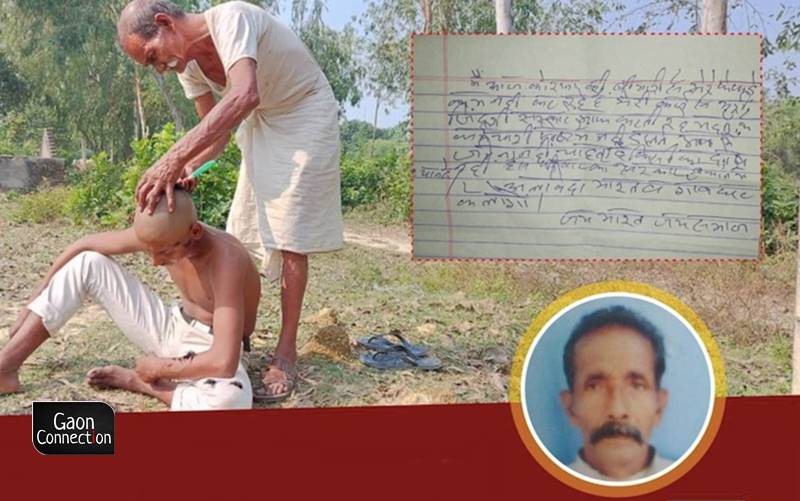An incoherent note is all that is left of 65-year-old Anil Kumar Singh. He was a farmer from Sandilva village in Mitauli tehsil, Lakhimpur Kheri district, Uttar Pradesh. On October 29, he was found dead in his field.
The ‘suicide note’ he left behind revealed that the COVID19 pandemic had affected his lungs and that he was heavily in debt. “I do not want to live anymore,” was written in Hindi on the piece of paper.
“There is the debt that was bothering him and then the rains on October 17, destroyed two acres of his paddy crops. He even registered his grievance on the chief minister’s portal,” Ravinesh Singh, the deceased’s elder son, told Gaon Connection. He said that his father owned about seven acres (2.8 hectares) of land.
Anil Kumar Singh leaves behind a wife, three sons, three daughters-in-law and three grandchildren.
About 150 kilometres away from Anil Kumar Singh’s village is Sagra village that falls in Tirwa tehsil of Kannauj district, Uttar Pradesh.
Nanhelal, a 55-year-old farmer who lived there and had cultivated potatoes and paddy on his three-acre land, lost 80 per cent of his crop to the relentless rains from October 17 to 19. On October 23, he died by suicide.
Meanwhile, in Lalitpur district of the state, since October 20, two farmers died by suicide. It was alleged that both died because they did not get fertilisers on time for their crops. On October 25, Soni Ahirwar, a 45-year-old farmer, died while the following day, it was Ballu Pal from Pali village who died.
According to the Accidental Deaths & Suicides in India – 2020 published by the National Crime Records Bureau (NCRB), last year there were as many as 10,667 people associated with agriculture and farming who died by suicide. Of these 5,579 were farmers and 5,098 were farm labourers. The agriculture related suicides for the year was seven per cent of the total national suicides.
Also Read: Farmer suicides dropped but suicides among agriculture labourers rose in 2020: NCRB
According to the NCRB report, there has been a hike of 18 per cent in the number of agricultural labourer suicides in the country. In 2019, 4,324 farm labourers had died by suicide while in 2020, the number had risen to 5,098. In the same time period, there was a slight dip of six per cent in the number of farmers dying by suicide.
Overwhelmed by debts
Apart from the crop losses, for the past two years, Anil Kumar Singh of Sandilva village was also spending nearly Rs 25,000 a month to treat his wife for cancer. According to his relatives, he had an unpaid debt of about Rs 200,000.
Ravinesh Singh, Anil Kumar Singh’s son told Gaon Connection that on July 1 this year, his father had received a recovery notice from the cooperative bank, demanding he repay the principal amount of Rs 76,410 and the interest of Rs 43,811, the total amounting to Rs 120,221, which he had defaulted payment on.
The bank notice warned Anil Kumar Singh that if he did not repay the amount in fifteen days time, legal proceedings would be initiated against him, the grieving Ravinesh added.
Earlier, on March 31 this year, the Punjab National Bank had sent him a notice to repay a loan of Rs 72, 902 on his Kisan Credit Card.
Mahendra Pratap Singh, the district magistrate of Lakhimpur Kheri told Gaon Connection that he was not aware about the matter and he would get back after finding out more.
Inquiry into the matter
On hearing about the death of Nanhelal, a resident of Sagra village in Kannauj, Rakesh Tyagi, the sub-divisional magistrate and the tehsildar, along with other officials visited his fields.
“Nearly eighty per cent of the deceased’s crops are damaged and the report has been sent to the district magistrate,” Tyagi told Gaon Connection. Once the matter was examined by the district magistrate, compensation would be paid to the family of Nanhelal, he added.
Since October 17, many districts in Uttar Pradesh were lashed with incessant rains, which subsided only on October 20. Heavy rains displaced several villagers and also led to considerable damage to paddy, sugarcane, banana and vegetable cultivation in the state.
Five out of the seven tehsils of Lakhimpur Kheri were inundated in the three days of continuous rains in the district. Added to the watery nightmare was the more than 500,000 cusecs of water released from the Banbasa Barrage at Uttarakhand. The Himalayan state has been hit by heavy rains causing landslides and killing at least 52 people.
The waters released from the Banbasa Barrage in Uttarakhand entered several villages in Pilibhit, Lakhimpur Kheri and Bijnaur where alerts were issued. The army and the National Disaster Response Force were called in for rescue operations.
In a meeting in Lucknow, on October 18, Chief Minister Yogi Adityanath called for a report from the districts on the extent of crop damage. He asked the district magistrates to prepare a detailed report on the loss to life, property, cattle, homes, etc. Once that was done, compensation would be speedily paid to those affected, the chief minister had said.
With inputs from Mohit Shukla in Lakhimpur Kheri and Ajay Mishra in Kannauj, Uttar Pradesh.
Read the story in Hindi.













